The riding season has started, and bikers everywhere are excited to climb back on their machines, myself included. As a result, I often hear the question: which modular helmet is best for me? Well, that’s what I will tell you in this review.
I’ll take you through the most important aspects and give you my opinion on which modular helmet is best for which type of rider. Let’s dive right in!
If you were to ask me my opinion on the five best modular motorcycle helmets, then these five would be in my lineup, and I’m going to tell you why.
But, if you want to skip the fluff and see which in our opinion is the best modular helmet then click here.
Best Modular Flip Up Helmets
Table of Contents
We all know that every rider is different. Some riders travel around the world or use their bikes for work. Others only go out for a couple of hours once or twice in the summer.
Not all modular helmets are the same and won’t fit every type of bike. So I’m also going to show you a few key specifications and offer you my opinion on some of the features that make these helmets unique. By the end of this review, you’ll know which helmet to choose!
Nolan N100-5 Plus
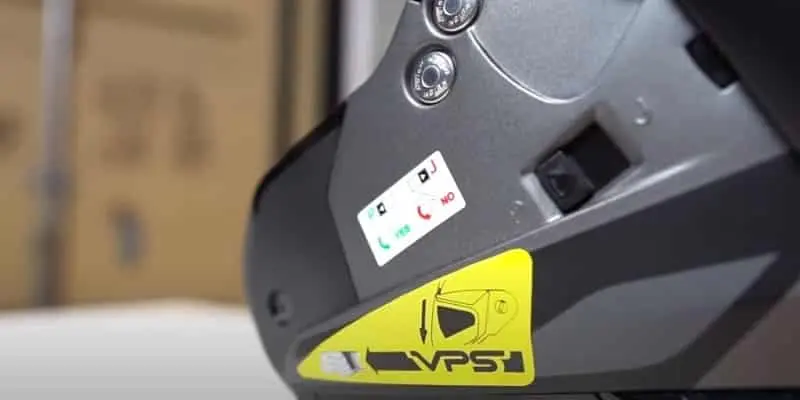
If we’re talking proper tour helmets, we can’t skip the Nolan N100-5 plus. Nolan has been in the game so long that they’ve invented some useful features not found on any other helmet.
Even Coppers put their trust in these Italian stallions. Nolan differentiates itself from the rest by using the strong Lexan polycarbonate material for all their helmets.
Outer Shell
This material is stronger than a regular polycarbonate, making this helmet an interesting competitor in its price category. But, of course, the outer shell isn’t the only thing that makes the N100-5 plus special.
The front of the helmet reveals two red levers, the so-called dual action locking mechanism. You must press down both levers to open the chin bar.
This is a safety feature as the chin bar can never suddenly open. And secondly, it makes sure that you’re always able to find the levers even when wearing thicker gloves.
When opening the chin bar, something special happens. The chin bar has a double hinge system, so it doesn’t only go up but it also falls back on the shell.
And this has been done to keep the helmet as compact as possible when opened. This is obviously so that you catch less wind. But, again, this is unique to the N100-5 and N100-5 plus.
This modular helmet also features the P/J homologation, just like the previous two models I’ve shown you. So it’s legal to ride on public roads with the chin bar either up or down.
Visor
The large visor at the front offers great viewing angles, and even the pinlock anti-fog lens, which is included, matches the visor’s size.
The N100-5 Plus also has an integrated Sun Visor, which can be adjusted in four steps.
Has the Sun scuttled off? No worries. Press the spring-loaded button, and it magically vanishes.
Bluetooth
Nolan has developed a few communication systems together with Sena. One of these N-Com systems is equipped with ESS, the emergency stop signal.
This is an extra brake light mounted on your helmet’s back. If you hit the brakes harder than average, the bright red light will warn other road users.
The Nolan N100-5 Plus has an adjustable inner lining. In addition, the so-called line of pad control allows you to slightly move the top of the center pad to help soften possible hot spots or pressure points.
Ventilation
It’s also fully pierced and combined with the large ventilation inlets. As a result, it offers efficient ventilation and air circulation.
The underside of the helmet features a neck roll that you can tighten to help eliminate air from the bottom, which helps keep the helmet quiet and warm.
The Nolan N100-5 plus is a real tour helmet. You can use it all year round in all weather conditions. Nolan works hard to make their helmets as safe and comfortable as possible.
And they’ve passed again with flying colors. Again, Nolan works hard to make their helmets as safe and comfortable as possible. And they’ve passed again with flying colors.

Scorpion EXO-Tech
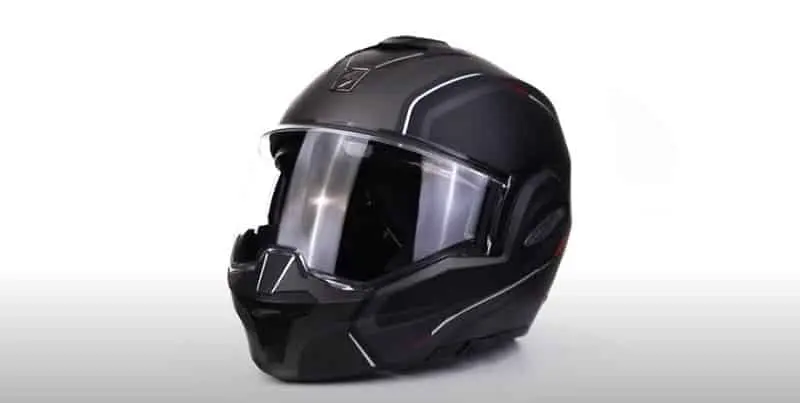
Outer Shell
The Scorpion EXO-Tech is a complete modular helmet or, if you like, a hybrid helmet. This helmet has a thermoplastic outer shell which does make it a little bit of an outsider in this lineup, but that doesn’t matter as it matches the price.
The thing that makes this modular helmet so unique is the chin bar that can be flipped to the back of the helmet. Hence, the hybrid.
This system is similar to the Roof Boxer flip-up helmet system but for a friendlier price. Flipping the chin bar all the way back is a neat feature, especially if you do a lot of urban riding.
It adds a lot of comfort on hot days when you can transform your closed, modular helmet into an open-faced one within a second.
And it’s nice that the chin bar doesn’t hang around on top like traditional modular helmets. That causes the wind to yank at your head more at higher speeds.
Something that the Scorpion EXO-Tech will do much less when worn in the open position.
The helmet features dual homologation meaning that you’re legally allowed to ride around with the helmet closed or open. It’s your call.
(Always Check Local Laws Before You Ride In The Open Position)
Anti Fogging
The Scorpion EXO Tech has a pin lock anti-fog lens in the box. In plain English, this is like double glazing windows, ensuring your visor doesn’t get all fogged up.
The pin lock is the same size as the visor; thanks to this, there won’t be any lens edges obscuring your view.
Visor
Speaking of the visor, imagine if you’re riding on a nice country road with your chin bar up and your visor down.
This can be a very comfortable configuration, especially on hot days. But then, you need to join the highway, and you want to close the chin bar.
Well, how do you do it? It’s simple as can be. Grab the chin bar and pull it over the top. You’ll see that the visor automatically retracts, making it quick and easy to change the configuration back into full-face mode without thinking about it.
This clever system is one of the reasons that this helmet is so unique compared to other helmets. Of course, the helmet features a Sun Visor, which can be operated using the slider on the left side of the shell.
Ventilation
The ventilation inlets are easy to operate with the switches on the top and the front of the helmet. So who is this helmet for?
As always, this is something that’s largely open to one’s own interpretation. In my opinion, this helmet works best for tour bikes and motor scooters.
It’ll probably perform best within and around the city limits. Are you planning on doing a lot of riding for work or maybe traveling?
Then you might be better off with a different modular helmet, but I’ll get to that soon and show you what I mean.

Roof Boxer V8
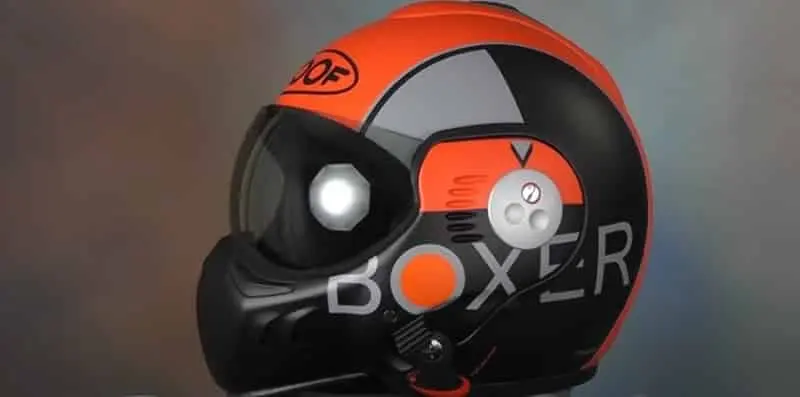
If you only look at the specs of this helmet, then you might wonder why the Roof Boxer V8 belongs in the lineup of the five best modular helmets.
For instance, the visor has no pinlock anti-fog lens, and the chin bar doesn’t click into place as easily as the one on the Scorpion helmet.
I think these things define this helmet, which belongs in this lineup. Just by looking at the helmet and its functionalities, it shows great style and quality.
It’s the best-sold helmet within the city and urban areas, and that’s saying something. The helmet shares a trait with the EXO-Tech. The chin bar can be rotated to the back, revealing the famous devil horns.
Outer Shell
This modular helmet from Roof has a fiberglass outer shell which offers a strong helmet shell with relatively low weight making the shell superior to the Scorpion.
Regarding looks, the Roof Boxer matches Harley’s and custom bikes perfectly. But to be honest, you can easily wear this helmet on your naked bike or motor scooter if you’d like.
The cool looks bring lesser aerodynamics in this case and are best used in and around the city limits. Riding with it in summer will be a treat, but the helmet will be less practical on the motorway.
Visor
I want to briefly jump back to the subject of the looks because you can buy a lot of cool visors for this helmet to customize the appearance to your taste. The Boxer is also available in a few different versions.

Shark Evoline 3 ST Helmet
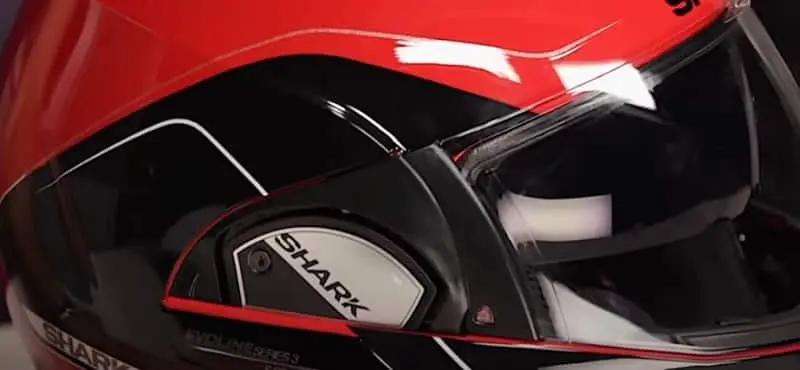
The Eva line Series three modular helmet is one of the most sophisticated modular helmets available, it’s a great solution for the rider looking for a helmet that combines the debris protection of a full face and the ability to be worn as an open-face at speed.
Construction
The Eva line is constructed using an injected thermoplastic resin and it’s DOT, ECE and AS approved. The AS sticker is only found on helmets bought from offline dealers in applicable areas so you’re not going to find one and a helmet purchase online.
This helmet also has received a five out of five scores from the sharp safety helmet assessment and rating program, that’s available in a myriad of gloss and matte-finished solid colors and some subtle yet sharp-looking graphics.
Helmet Sizes
The fit is sort of unique and the helmets are only available up to a size XL. The fit of the Eva line 2 was completely wrong as it couldn’t be worn by anyone with a head that even hinted at the oval shape.
The new 3 Series has an intermediate oval head shape out of the box, it still doesn’t fit long oval head riders but I found a memory foam pad behind the liner at the forehead that when removed allowed me to wear this large comfortably.
The new series 3 is also lighter than the 2 by almost 200 grams and the liner which we’ll take a closer look at here shortly is much softer and more comfortable.
Features
Most of you are probably most interested in the chin bar, this new setup is pretty amazing. The previous model design required the shield to be brought to the fully up position before the chin bar could be raised, but not anymore.
When you press the lever to raise the chin bar a little tab comes out and begins to raise the face shield, the chin bar path also contributes to this one-step process.
When you press the release lever the chin bar releases forward instead of straight up, this allows the chin bar to clear the face shield easily.
The shape of the channeling in the side plates helps the chin bar to rest flush against the shell when in the rear position, this creates the most aerodynamic profile possible.
It’s important to remember while the chin bar and face shield raising process has just a single step, lowering the chin bar may require two.
It’s important that the face shield is in the raised position when the chin bar is lowered and once the chin bar is lowered you can then return the face shield to the down position.
It’s also important to remember to press the chin bar in toward the shell until it clicks into place and make sure that it’s locked in the down position.
If you need to remove the face shield you simply press the tab located on the side of the helmet and pull forward on the shield. If you can’t apply enough pressure with your fingertip to release the tab there’s an indentation on the tab that allows you to use a pen to get pressure.
Lift up gently on the shield with the tab pressed in to get the removal process starting, then hold the helmet with one hand and pull out on the shield with the other.
When reinstalling insert the top edge of the shield first then press the bottom edge until it clicks. The next feature I want to show you didn’t get an upgrade at all over the previous model.
The internal sunshade is the same as it was on the series 2 helmet but the reason it didn’t change is that it’s already excellent.
The mechanism to raise and lower the shield is really easy to operate with gloves on and it’s simply designed.
There’s very little with the system that can fail, there are no Springs or locking mechanics at all, the coverage is also good and there’s very little refraction.
Removing the sunshade takes a little bit of courage the first time but it’s easy. To remove the face shield to get it out of the way use your pen from the shield removal and depress the tab on the top of the center of the shade.
Pull the shade down until it’s clear the tab and retract the tab back into the helmet to get it out of the way, here’s where the courage comes in.
Get a good grip on the shade as close to one edge of the eye-port as possible and pull straight out, repeat the process on the other side, and of course, reverse the process to reinstall.
Ventilation
There is a two-position vent on the chin bar to assist your shield fob and a two-position vent on the forehead to channel air to the crown. There are no exhaust ports of any kind on this helmet, which if this helmet had a flaw, that might be it.
Air circulation throughout the helmet does get significant help from the EPS design, we’ll get to that in a minute when we look at how to remove the liner.
Interior
This helmet liner is one of the more sophisticated liner setups they’ll find. The cheek pads snap in and remove in the normal way, of course, these cheek pads have to be fancy, this is the Eva line for crying out loud.
The black and neoprene area on the top of the pad has a special function, there’s a pad on the inside that when installed works to reduce wind noise you can also remove the pad to make it more comfortable with eyeglasses.
With the cheek pads removed you will see the cutouts for the installation of speakers, these removable inserts also work to reduce helmet noise.
The headliner also comes out in the usual way they’re snaps at the rear and a plastic ridge at the front that snaps into the shell.
The channels in the EPS are the feature I mentioned earlier that help with the airflow. The Evoline ST modular helmet from Shark is a top-of-the-line option for the street rider looking for the best from the full-face and open-face style helmets.
In Conclusion
The Shark Evoline 3 ST is the latest helmet from the Shark Evoline family. It’s equipped with the most advanced and durable materials available on the market.
It’s also the first in its line to feature the Sharktooth-ready technology. The Sharktooth-ready technology makes this helmet the best motorcycle helmet in the world.
The integrated drop-down sun shield protects you from the harmful rays of the sun. The removable and washable CoolMax liner is designed to protect your head from the elements. The EVOLINE 3 ST is DOT approved.

HJC RPHA 90 Modular Helmet
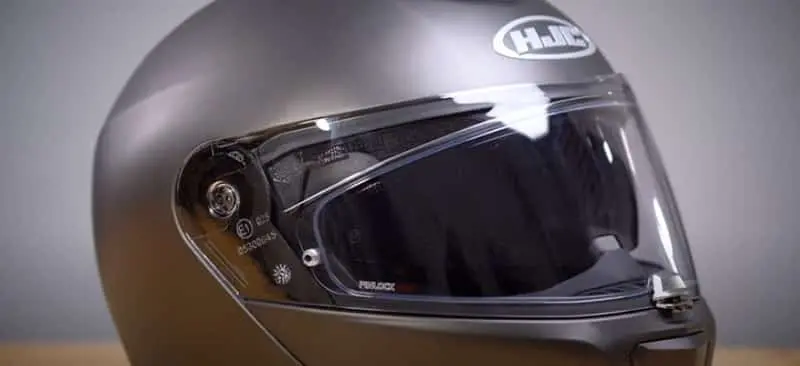
The HJC RPHA 90 modular motorcycle helmet is the new high-end flip-up helmet by HJC helmets from Korea. And did you know that HJC helmets are the largest helmet manufacturer in the world?
This is HJC’s pride and joy, the newest high-end flip-up helmet which completes the RPHA line. The RPHA line contains the RPHA 11, which is the full-face racing helmet, and also the RPHA 70 which is a touring/sport full-face helmet.
Now this one has the best of both worlds, or should we say the best of all worlds, which are three to be exact.
Safety
Starting with the first one, which is safety and protection. The outer shell of this helmet is made from the P.I.M.+ technology which is a layered fiber mix.
This means that different types of fibers such as aramid fiber, carbon fibers, and fiberglass – have all been used in different types of layers and put all on top of each other to create a very strong and lightweight shell.
This has definitely worked because the helmet weighs around 1500 grams. This is the size medium if you get a size small or size large you’ll have a different shell size.
So it could be a little bit lighter or a little bit heavier, but overall these helmets are pretty much the lightest flip-up helmets around now.
If you take a look at the front of the helmet, just under the visor which if you open up you will see two reflective panels.
They have been placed there to increase visibility to make sure other road users can see you in the dark. And they have also been featured on the bottom of the helmet just around the neck roll.
Chin Strap Retention System
While we’re looking at the underside of the helmet let’s take a look at the new micro buckle retention system, which is now made from stainless steel.
Before these were made from plastic but now it’s become a lot safer as it’s made from metal.
It also has two notches at the beginning, which are basically one notch but welded together, and you need to push it through those two notches to actually lock it. So it’s actually extra safe.
Sports Features
That brings us to the next world, which is the sports world. It does have a lot of sporty features as it does come from the RPHA family. Which has the RPHA 11 – a very sporty helmet and the RPHA 70 sport and tour.
This helmet has a very, very compact helmet shell. So as we already mentioned before it’s very light and strong, but it’s also one of the most compact shells around on the market for a flip-up helmet.
Design
HJC has gone with a very clean look and very clean design. There are no external spoilers or anything like that but there are a couple of small fins at the front to stabilize the helmet. Apart from that, it has a very clean look.
Aerodynamics
HJC has its own wind tunnel which is where they have tested the helmet and optimized it for aerodynamics.
So all this has a reason and the shell does have a very nice shape which you would see better in real life but it’s got a lot of thought gone into it. Now we’re going from that part, we’re going to look at the visor.
Visor
The visor is actually not really that big, a lot of helmets these days are getting really long visors, but that also means that the chin bar is going to get a little bit smaller – so less protective. They’ve kept the shell intact and kept the visor to normal size.
The visor has an extra lock on the front, so you actually have to lift up a button situated at the front/bottom of the visor to open the visor.
And when you close it, it falls into place and it locks so it cannot be the case that the visor would accidentally open while riding.
And if we take a look at the mechanism that the visor is connected to, this part over here is a very quick release.
You can just open up the button and it comes right off, you can replace it with a dark visor or anything like that – works perfectly.
Ventilation
There are large vents on the top and on the chin which can both be opened and closed. The one on the rear: the outlet – this can also be opened and closed so you can choose if you want your helmet to breeze, to give you the nice summer breeze, or if you want it to be completely airtight.
Sun Visor
Now moving on from the ventilation to the sun visor on the inside. This is something that the RPHA 11 doesn’t see, as it is a racing helmet, but the RPHA 70 which is the tour/sport helmet – does have one.
This one is not different, however, it does have a very wide sun visor which is anti-scratch and has received an anti-fog coating.
It can be controlled using the slider on the left side of the helmet, which is different from past flip-up helmets by HJC where it was often on the top of the helmet, so this is slightly more convenient I would say.
Interior
If you wear glasses they are not an issue because you can just put them right in – there’s been some room spared inside for your glasses.
The interior is a 3D-shaped interior, which means that it’s supposed to fit your head very snugly, very tightly – which eliminates the wind noise while riding.
It’s also a Polygiene Odor-free interior, which is a brand that uses their stuff in sports shirts and things like that to eliminate bad odors. Which is not very nice inside your helmet.
If you looked at the underside you would see there are a couple of flaps around the neck roll used to enclose the neck to make sure the noise and the wind are all isolated, so there will be no cold and no noise at the bottom of the helmet.
The same goes for the chin curtain at the top, and this is something we’re seeing in a lot of modern flip-up helmets – to make sure that it really does enclose around the neck.
In Summery
You have a high-end flip-up helmet by HJC which is designed for touring and sports riders, it comes with a five-year guarantee – which is very generous.
It comes with a max vision Pinlock anti-fog lens and it is also prepared for communication.
If you want to install a communication device that is as discrete as possible, you can take a look at the Cardo Smart-H system, which has been designed especially for HJC helmets.
Now the price of this helmet is circa $400 in a basic solid color: that could be matte black, that could be glossy white, that could be fluorescent yellow – they’re all the same price.

Shoei Neotec 2 Modular Helmet
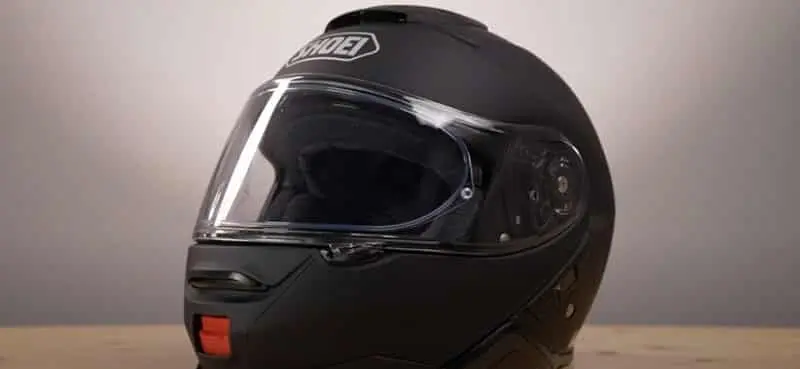
Normally there is a Pinlock anti-fog visor in the box when your helmet arrives but don’t worry if you can’t find it as Shoei has already placed it inside the visor, at least ours was when we opened the box.
Check out our article Shoei Neotec 2 Modular Helmet Review
Construction
The first thing I’m going to tell you is that this helmet’s outer shell is made from a multi-fiber A.I.M. material, and the inner shell is made from EPS with a dual-density.
So you have a very strong helmet on your head and it’s also relatively light. It weighs about the same as the Neotec 1, so there’s not much change there.
However, it is a lot quieter than the Neotec 1. So they’ve made it a lot more noise resistant – and I’ve heard rumors that it’s quieter than the Schuberth C4.
Now we have not tested this yet ourselves, but I do sense a little competition over here.
Ventilation
Now getting into why this helmet is so quiet. The ventilation has been vastly improved. On the chin, you have a big ‘pet lip vent’ flip out, which if you open you have a large opening for the chin ventilation.
The same goes for the top ventilation, they have made the design so that the air flows perfectly into the ventilation.
It has two different settings you can put it on, simply by sliding the top forward or backward. The outlet at the back of the helmet cannot be closed, but it also acts as a small spoiler.
Aerodynamics
The helmet has a two-point spoiler: it has one near the top rear of the helmet for people who are more like tour riders, and for people with a more sporty bike there is a second spoiler just below the first to make sure that your helmet does not yank at your head.
Visor
Another striking part of the front of the helmet: is the visor. The visor has also been improved it now has curved edges, which is something new.
It’s a little bit like your smartphones of today. It has curved edges all around and when you open the visor it comes forward a little bit.
So when you open and close the visor, it actually sucks against the rubber seal around the visor, so it’s completely windproof – and that does a lot of good stuff for the noise isolation.
Chin Bar
To open the chin bar using the Shoei system you have to press the button on the chin bar to lift the chin bar and when it’s open, it’s open.
You can push it back another notch, this has been done for the dual homologation (the P/J approval). And it’s kind of like an extra lock for the chin bar, so that’s a really safe and good idea.
Sun Visor
Another thing that makes the helmet comfortable is the sun visor, which we also saw in the original Neotec. It’s in the same place, it can be operated from the left side of the helmet and that’s all anti-scratch. It’s really really long and has a nice visor which is useful.
Interior
They have changed the cheek pads, the interior feels pretty similar but the cheek pads have been made to give better noise-isolating.
They’ve improved the fit slightly, but it still feels as comfortable as the Neotec 1. It’s the original Shoei comfort that we all know and love.
Chin Straps
This modular helmet comes with a micro ratchet stainless steel strap, which needs to be opened all the way to release the ratchet from its lock.
Under the ratchet you will see two extra flaps, they are made from leather and they go at the bottom of the strap to connect with the chin curtain, this seals the helmet around the chin area to cut out wind noise.
Communications
With this modular helmet, they seem to have thought about everything and including the communication system, which has been designed by SENA.
There are two parts on the side of the helmet that will be replaced with the SENA parts, there is a place for the battery on the back and all the parts on the inside have been hollowed out so you don’t have to drill any holes, you don’t have to stick anything in.
Colour
The matte blue version is not the only one available, there is also the matte black. (word of caution) The matt colors show up every mark and scratch so you need to be very careful handling the matt helmets or they start looking scruffy very quickly.
In Conclusion
Designed to withstand the elements, the Shoei Neotec 2 is a modular helmet that offers a wide variety of fit, comfort, and protection.
It features a dual-layer EPS liner that provides enhanced impact absorption and ventilation.
Aero shapes provide additional benefits, including optimized airflow and increased aerodynamic properties. Four shell sizes and five liners offer a comfortable fit that helps to comfortably fit most head sizes from XS through XXL.
The exclusive, state-of-the-art shell forming technology incorporates the aerodynamic advantages of a spoiler right into the shell of the Neotec 2.
This allows for optimal airflow without compromising the helmet’s performance and comfort. A vortex generator on the face cover and visor works to reduce noise and manage airflow around the helmet.

LS2 FF399 Valiant Modular Helmet
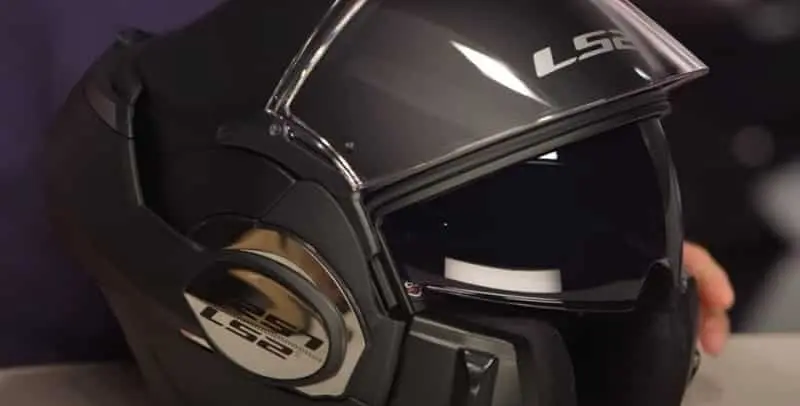
The LS2 FF399 Valiant Modular Helmet is a modular lid that LS2 designed to be well balanced and stable and is.
The exterior shell is constructed from LSU’s KPA material and it’s designed to be up to 20 percent smaller than competing models.
Shell Sizes
They use two shell sizes for the valiant, the smallest size is used for extra small up through large and then the larger shell size is used for extra-large and above.
Chin Bar
One of the things that makes a valiant really unique is the 180 degrees flip-up chin bar, this design provides a couple of things.
When it’s in the full-back in the locked position it creates a better balance for the helmet so you know when you’re riding down the road you’re not feeling as much neck fatigue, as with other modular helmets that will leave the chin bar somewhere up near the brow of the helmet.
It also removes that sail-like effect that you can get with some modular helmets when you have that big chin bar catching in the wind.
Visor
You’ll also notice that the face shield looks a little bit different than most normal helmets, LS2 puts the tab up on top and that’s part of giving clearance for the chin bar.
It’s also the reason that the face shield retracts and moves when you’re either locking it into place or you’re setting it back into the full-face position.
Fully Locking Mechanism
The chin bar is designed with a full locking mechanism, they use metal parts inside to keep it nice and secure, and LS2 to has made it so that if you dis crash with the chin bar down it’s not going to flip up even if the face shield happens to get torn off.
Sun Shield
This is also a twin shield helmet which means it’s got an internal drop-down sun shield. It’s operated by a little stainless steel cable-actuated slider on the side of the helmet, it gives you a little bit of eye protection in bright conditions.
DOT and ECE Approved
Another key feature is that this helmet is DOT and ECE approved for safety. It’s homologated as both a full-face and an open-faced helmet
Ventilation
The top brow vent up has an open and closed setting and so does the chin bar vent. The vents around the back of the helmet stay open all the time to maximize airflow.
The LS2 has cut channels in the EPS liner inside to make sure that the air is able to move freely from front to back.
The lining inside makes use of hypoallergenic material that’s applied directly to the laser-cut foam and that’s to avoid having to use so much glue that you might find on other manufacturers’ interior liners.
It gives it a comfortable feeling, especially for those that have a more sensitive skin
Chin Straps
The valiant also comes with a DOT-approved quick-release chin strap, it’s a hallmark of a lot of LS2 helmets. Just slide it in and it stays nice and secure, you pull the tab and it comes right out.
Features
LS2 really set out to make a well-balanced modular helmet that was going to meet the needs of people who were sick of feeling like they had a brick on their heads.
The 180-degree design chin bar, and the attention to detail on the interior they’re all going to be these small elements of a helmet that people are really going to appreciate.
In Conclusion
The LS2 FF399 Valiant Modular Helmet is the first modular helmet to feature a new KPA shell that delivers a more comfortable fit and protection than any other modular helmet on the market.
The LS2 FF399 Valiant is the first modular helmet to feature a removable, washable, moisture-wicking comfort liner and a drop-down sun shield.
This lightweight helmet is made to withstand the rigors of daily wear and tear.

HJC CL-Max 3 Modular Helmet
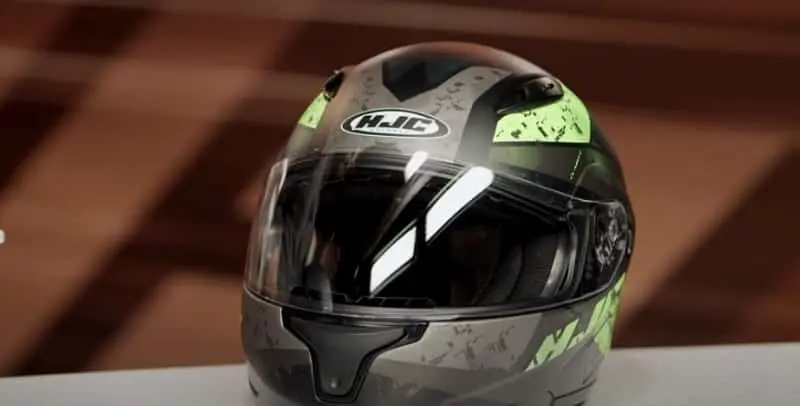
The CL max 3 is the newest version of the CL max line. It replaces the CL max 2 and in this post, we’re going to show you what you can expect for around the $140 price point from HJC.
We’re also going to talk about the upgrades you’re getting over the previous version of this helmet. To start things off this is a modular helmet so, if you are looking for the entry-level modular helmet with an HJ’s line, this is the one you’re looking at.
For around the $140 dollar price point, you get a Polycarp shell, you get one shell size with four EPS liners which differentiate the sizing for this helmet. It is a DOT-rated helmet and comes with two intakes and two exhausts.
You will notice the intakes on this are going to be different than the previous version and we will talk about that venting scheme in one minute but the real story here is the fit.
Fitment
This is an intermediate oval helmet, which means it’s a little bit longer front to back, a little bit narrower down the inside of the head and it will work for the majority of your riders out there in the American market.
Sun Visor
This helmet is slightly heavier than the previous version because the real upgrade that we’re seeing with this is the internal Sun Visor. The actuator for this sun visor can be found on the top of the helmet.
If you upgraded to something like the IS-Max which stands for internal sun visor max, that was previously the model that you had to upgrade to if you wanted the internal Sun Visor.
What you don’t get with this one is you don’t get a spring-loaded three-position Sun Visor, this is just up and down and you have to actuate it yourself.
With this sun visor, you are either fully open or fully closed, with nothing in between. If you upgraded to the IS-Max, for example, you would but bear in mind the IS-Max is adding an extra fifty-sixty dollars to the price tag.
If you were to bump up to that helmet you would have an internal Sun Visor but again this is going to increase the weight, that’s where we really started this whole point was this is now going to be four pounds in a medium so it’s about six to seven ounces heavier than this CL-Max.
Ventilation
I like this because it’s a lot easier to reach up and flip back for open and down for closed than it is to try and figure out which one of these snaps is in the right position and you have to do it on both sides.
Anti-Fog
This helmet now comes with a pin-lock-ready face shield included, the previous version didn’t have that.
You’re not getting the pin lock insert in the box but you are getting the face shield so if you want to add a pin lock to this all you have to do is buy the insert.
Pin lock if you’re not familiar is a fog-resistant shield that you can put inside of this visor. For colder mornings or for days when it’s raining and you’re face-shield tends to fog up pin lock helps to eliminate that problem.
Ventilation
The vents at the back of the helmet have changed, and the shape of the helmet has also changed from the previous version.
It’s a little bit more sport touring now, a little bit less aggressive because they’re realizing that the average person that’s looking at a modular helmet is probably going to use it for touring purposes and they’re not taking this to a racetrack
You are getting a little bit of a larger shell and part of that is to accommodate that internal Sun Visor as well so just keep that in mind.
You’re also losing the pre-housing for the Bluetooth for their proprietary unit, what HJC realized was that they wanted to give people options as far as which unit they wanted to use.
With the new unit you can use pretty much any of the universal comm systems, they will clip onto the side and there are still speaker cutouts for the inside of this helmet.
Interior
This helmet has a really nice chin curtain and this is something that’s in addition to the previous version.
It has a little bit of a nicer thicker feel to it and it just gives you a really tight closure when this is in the closed position. It helps to stop the wind from pushing up and cuts down on noise a little bit.
This helmet has metal posts that give you a much more secure closure than what you’re seeing with some of the other entry-level modular helmets that utilize plastic.
If you remove the cheek pads you will see this helmet has speaker cut-outs making it comms ready.
This helmet comes with a brow-mounted interior which adds comfort, you don’t have the snaps inside the foam which puts pressure points on your forehead.
It also comes with a nice channel cut out for the inside which helps to push that airflow from the front to the back.
What you’re seeing is a refinement over the CL Max2 and again the CL max2 was a solid entry-level modular helmet.
This is getting a slight bump in price about a 10 to 15 dollar bump in price over the previous version.
That does depend on whether you’re going with a solid or a graphic design helmet but really what you’re seeing for one hundred and forty dollar price point is a nice upgrade from what you had with the CL Max2.
You’re getting extra features like that internal Sun Visor, you’re also getting the pin lock-ready face shield.
I like what they’ve done with the venting on this helmet, the only thing that you would want to consider bumping up to the IS max for is the IS-Max gets you two shell sizes so it’s going to be a slightly smaller helmet.
For around $140 dollar price point and for those of you out there looking at just getting a taste of what a modular helmet can give you the CL max 3 is definitely an option for you to consider.
Let’s go ahead and just discuss some of those changes that you’re going to see if you decide to bump up to this helmet.
The first change you’ll see is the vents have changed, they’ve changed the design of the chin vent so you now get a cleaner line, they have also changed the twin vents on the brow of the helmet so you now have one large central event which is actuated with a switch.
Schuberth C4 Carbon
Flip-up helmets by Schuberth were previously purist tour helmets. Nowadays, that’s still the case, but the C4 Carbon is also classed as a touring sport.
This is largely down to the large jumbo visor with the same size pin-lock anti-fog lens. Thanks to the large viewing angels, this helmet is now suitable for use on sports bikes and naked bikes.
The large integrated sun visor can easily be operated by moving the slider on the left side of the shell. And you can even adjust it a little bit with the switch on the bottom.
Outer Shell
The C4 Pro’s outer shell is made from a rock-solid fiberglass Matrix which offers good impact protection.
The Pro Carbon, however, takes it one step further with its 100% carbon outer shell. This makes the shell even stronger and even lighter.
Bluetooth
The Schuberth C4 Pro Carbon is equipped with pre-installed speakers and a microphone. All the wires have been hidden within the helmet.
And the only thing that you need to do to use this system is purchased the SC1 standard or advanced and click it into place at the bottom.
The SC1 systems consist of a battery and communication module, so it’s very easy and quick to install. On that note communicating with other riders on the road shouldn’t be a problem.
Especially as the Schuberth C4 Pro is considered one of the quietest modular helmets in the world.
in the world.
The interior fits nicely and tightly around your neck and face, but it’s nearly impossible to ride the wind to find its way into the helmet unless you’ve got the vents in the open position.
Interior
The interior not only fits snuggly, but it’s also very comfortable. The velvet material is the most luxurious lining I’ve ever seen inside a motorcycle helmet.
It feels very soft, and it ups the level of wearing comfort. However, there are two things I’m less fond of.
One of which is the fact that this helmet only comes in two shell sizes. And the other one is that the helmet has no P/J homologation.
So they’re not deal-breakers, but it is something I’d expect to see at this price point.
The Schuberth C4 Pro Carbon will get you to your destination in a dry, safe and comfortable manner. In addition, the helmet can easily be used for long trips and traveling.

Our Top Pick
Shoei Neotec II
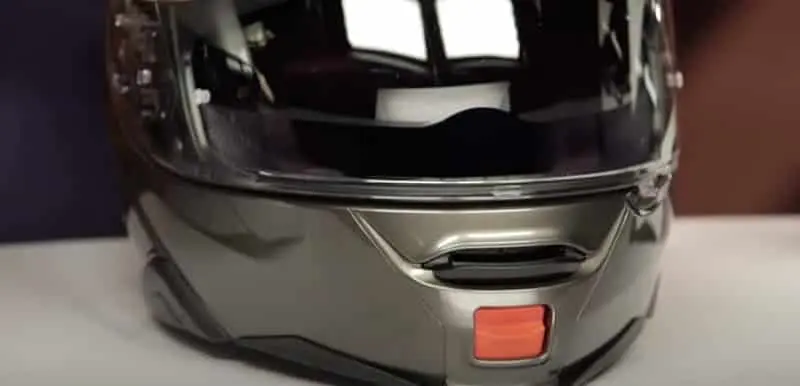
We’re not picking a winner from these five helmets, but if we did, then the Shoei Neotec II would already have a head start over the others.
The reason is that this helmet was released back in 2018, but it’s still in the lineup today.
The outer shell of the Neotec II is made from a few different materials. The so-called advanced integrative Matrix is built from multiple layers of fiberglass, Carbon, and Aramid fibers.
The outer shell also comes in 3 different shell sizes, a unique feature of this helmet compared to the other 4. As a result, the Shoei Neotec II has a fantastic fit.
This helmet genuinely fits the vast majority of people who try it on. But if there’s room for improvement, we can fix that with the Shoei personal fitting system. This is a unique custom fitting system developed by the Japanese helmet manufacturer.
The interior of this helmet feels soft, but also, at the same time, it feels durable. It might not be as soft as the interior of the Schuberth C4 Pro Carbon, but that one is hard to beat.
This helmet is not much different on the underside. The neck padding fits tightly around the neck to help eliminate wind blowing inside the helmet.
And it’s partly thanks to this feature that this helmet belongs to the category of the quietest modular helmet. In addition, the Neotec II brings a few special features not seen on the other models.
The curved visor edges are a good example. They are curved against the helmet shell as tightly as possible to keep the visor wind- and waterproof.
And, of course, the visor won’t fog up as you will get a pinlock MaxVision anti-fog lens in the box. The Sun Visor of the Neotec II is easy to operate with the slider on the left side of the helmet.
And if we close the chin bar and look at the front, we can see a small spoiler that works together with a ducktail diffuser and the helmet shape to create a stable and clever wind flow.
The wind won’t yank at your head so much at higher speeds. Another feature that charmed me is how you can lock the chin bar into place through the P/J homologation.
Unfortunately, the Nolan helmet requires you to flip a switch which can be difficult to find while riding. The Neotec II requires you to push back the chin bar twice to click into place, which is a double.
As Schuberth did, Shoei has developed a fully integrated communication system with Sena. The Shoei system is completely separate, whereas the Schuberth C4 Pro already has some pre-installed parts.
In theory, you could install a universal intercom in the Shoei Neotec II, but not as easily and stealthy as the Sena SRL1 or SRL2.
This helmet comes across as a touring helmet, but it’s a bit of an all-rounder. You can easily use this lid for long trips, traveling the world, going to work, or even something simple as popping into ASDA for some crumpets.
Where To Buy
| Brand | Sports Bike Shop | Revzilla |
|---|---|---|
| Shoei Neotec II | From £529 | From $749 |
| Shark Evoline 3 ST | Not Available | Under $200 |
| HJC RPHA 90 | From £324 | Under $500 |
| Shoei Neotec 2 | From £529 | Under $700 |
| AGV Sportmodular Carbon | Not Available | Under $750 |
| LS2 FF399 Valiant | Not Available | Under $300 |
| HJC CL-Max 3 | Not Available | Under $250 |
| Scorpion EXO-Tech | From £249 | Not Available |
| Nolan N100-5 Plus | From £359 | From $429 |
| Roof Boxer V8 | From £209 | Not Available |



